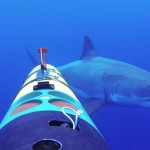 Late last year I looked at an innovative new project that was using drones to track the movement of sharks off the coast of Australia.
Late last year I looked at an innovative new project that was using drones to track the movement of sharks off the coast of Australia.
The nonprofit group Surf Life Saving Western Australia have attached tracking devices to known local sharks. The devices are designed to send out a warning message via Twitter whenever they come within a certain distance of the beach.
Observing shark behavior
Of course, that isn’t the only high tech way that sharks are being monitored. For instance, the REMUS SharkCam is an underwater drone, or unmanned vehicle, that has tracked sharks and captured some incredible footage of the creatures.
The project, which is the first to autonomously track an animal in a marine environment, was documented in a recently published paper.
“We wanted to test the REMUS SharkCam technology to prove that is was a viable tool for observing marine animals—sharks in this case—and to collect substantial data about the animals’s behavior and habitat,” the authors say.
The study involved six AUV missions over a seven day period during which four sharks were tracked and 13 hours of data generated.
With the majority of shark knowledge coming from surface observations, the footage provided rare insight into what happens in the sharks natural habitat.
Recombination
The technology was originally developed to help map and monitor coastal environments, but it has since been repurposed for a wider range of work.
It’s equipped with a range of water current profilers, salinity and temperature probes, six HD cameras and a range of other sensors that provide researchers with a rich data set on the animal and its environment.
The sharks tracked during the operation were fitted with a tag that was attached to the dorsal fin of the shark, which when the study was completed was released via an acoustic command and float to the surface to be retrieved by the research team.
Non-invasive tracking
Whilst this form of fin based tracking is pretty non-invasive, another innovation aims to monitor the oceans without attaching anything to the animal itself.
The venture, called Smartfin, attaches itself to a surfboard rather than to the shark itself, and allows the surfers to collect oceanic data as they ride the waves.
The device attaches to the board just as any other fin would, but it comes complete with a range of sensors that measure things such as PH, temperature and salinity.
It then transfers that data via Bluetooth to a mobile app, which then sends it on automatically to the Smartfin database where it can be viewed by all.
The project is working alongside the Scripps Institute of Oceanography to help improve the amount and quality of near-shore data to understand how things like climate change are influencing the oceans.
“We have detailed information about the deep ocean, but very limited accurate information about the near shore,” the team say. “Satellites can’t be really accurate with data in that narrow zone, and the other way is ocean buoys and they’re just not deployed at the coast. Bingo! Smartfin can fill that gap.”
They join the Datamarans that I wrote about recently that autonomously sail the oceans collecting data as innovative ways of monitoring the seas. Hopefully these projects, and others like them, will significantly boost our understanding of the waters surrounding us, and the life within them.